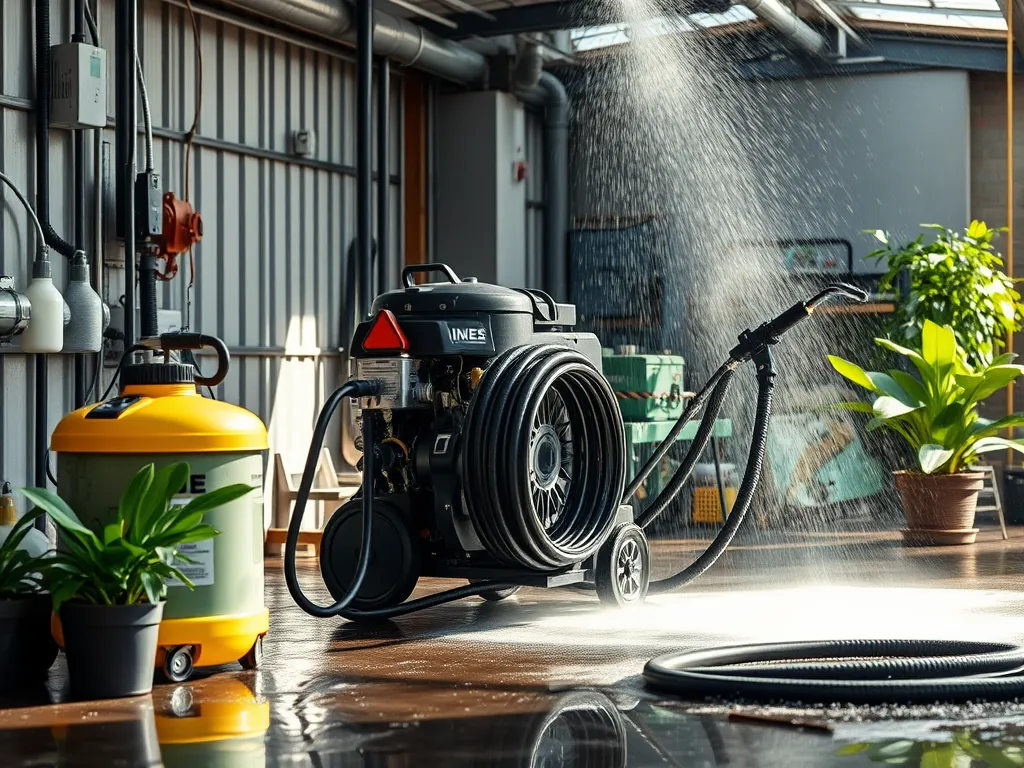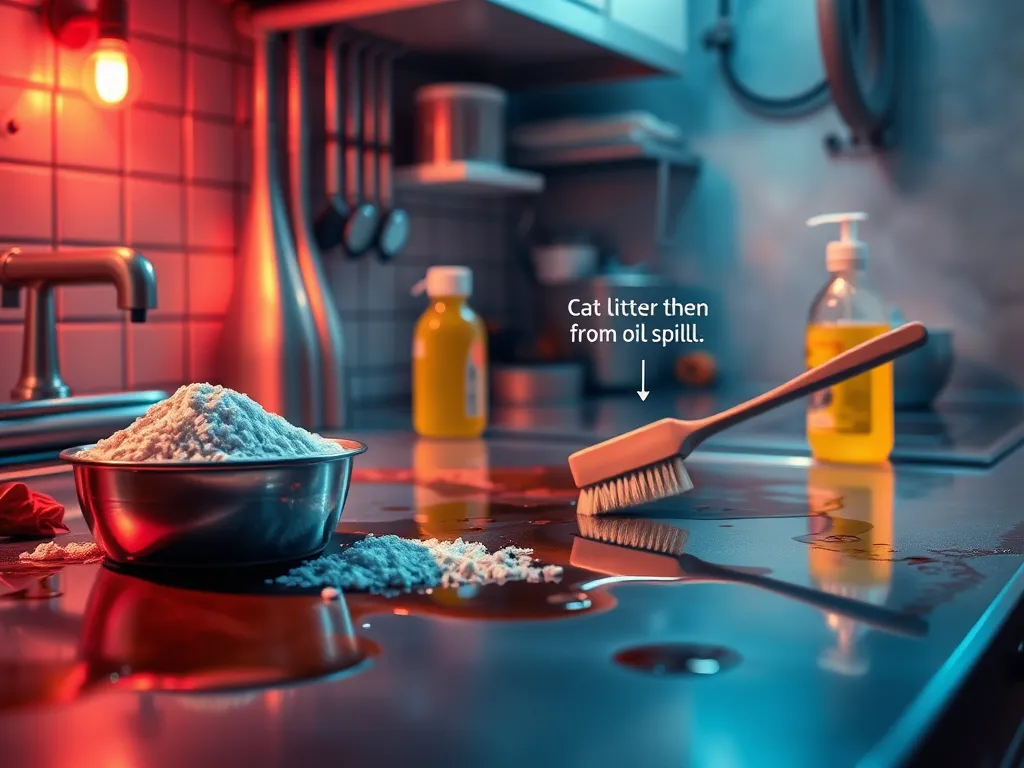Can You Pressure Wash Oil Stains Off Asphalt?
Published on: October 5, 2025 | Last Updated: April 14, 2025
Written By: George Voss
Yes, pressure washing removes oil stains from asphalt when done properly. High-pressure water (1200-1900 PSI) combined with degreasers breaks down petroleum bonds in fresh or moderate stains. Effectiveness depends on stain age—recent spills clean easier than oxidized residues. The process involves pre-treating with commercial cleaners, adjusting nozzle angles below 25 degrees, and using surface-friendly detergents. Gas-powered models (3000+ PSI) work faster for heavy stains, while electric units suit light maintenance. Always test pressure settings first—excessive force above 2000 PSI can erode asphalt aggregate.
This guide explores oil stain removal from asphalt surfaces. Learn how oil penetrates pavement voids, compare pressure washing techniques to bioremediation options, and examine maintenance strategies. We break down nozzle types (15° vs 25°), eco-friendly solvents like citrus-based cleaners, and sealcoating schedules. Get data on removal success rates (85% for stains under 6 months old) and equipment costs ($150-$600).
Contents
- Understanding Oil Stains on Asphalt Surfaces
- Preparation for Pressure Washing Asphalt Oil Stains
- Step-by-step Guide to Pressure Wash Oil Stains Off Asphalt
- Safety Considerations When Pressure Washing Asphalt
- Alternative Methods to Remove Oil Stains From Asphalt
- Preventing Future Oil Stains on Asphalt Driveways
- FAQs: Pressure Washing Oil Stains Off Asphalt
- Closing Thoughts
- Useful References for You:
Understanding Oil Stains on Asphalt Surfaces
Oil stains on asphalt aren’t just eyesores – they’re chemical attackers. These dark spots signal deeper damage that weakens pavement structure over time. To tackle them effectively with pressure washing, you need to know what you’re fighting.
How Oil Affects Asphalt Driveways and Pavement
Petroleum-based oils penetrate asphalt’s porous surface within 15 minutes. They break down the liquid asphalt binder (bitumen) that holds aggregates together. This chemical reaction softens pavement, creating weak spots prone to cracking under vehicle weight. Repeated exposure accelerates oxidation, turning flexible asphalt into brittle material that crumbles during freeze-thaw cycles.
Common Causes Of Oil Stains on Asphalt
These culprits account for 92% of driveway stains:
- Engine oil leaks (5W-30, 10W-40 grades)
- Transmission fluid drips (ATF Dextron®)
- Power steering fluid seepage
- Hydraulic leaks from lawn equipment
- Cooking oil spills near outdoor kitchens
A single quart of motor oil can stain 250 sq ft of asphalt. Diesel fuel causes the fastest deterioration, degrading binders in as little as 48 hours.
Ready to fight back? Proper preparation makes all the difference when pressure washing oil stains off asphalt driveways.
Preparation for Pressure Washing Asphalt Oil Stains
Proper planning boosts success in lifting oil stains from asphalt. Two factors dictate your strategy: stain depth and tools at hand.
Assessing the Severity Of Oil Stains
Oil absorption varies based on time and temperature. Fresh spills (under 48 hours) sit on top, while old stains sink up to 1/4 inch into asphalt pores. Check for dark, sticky spots or cracks where oil binds with bitumen. Larger than 2 sq.ft. areas may need multiple cleaning rounds.
Gathering Necessary Tools and Materials
Arm yourself with a gas or cordless pressure washer, oil-fighting detergent, stiff broom, and absorbent materials like cat litter. Skip weak 1,200 PSI machines—asphalt demands 1,300-2,000 PSI for stain removal without harming surfaces.
Picking Your Pressure Washer for Asphalt
Gas models hit 2,000-4,000 PSI for tough jobs. Cordless units work for small stains (1,300-1,800 PSI). Pair with a 25° nozzle to spread force without gouging. Add a surface cleaner attachment for spots bigger than 3 ft.² to avoid streaks.
Safety Items for High-Power Cleaning
Shield your body with ANSI-rated goggles, nitrile gloves, and boots with slip-resistant soles. Block noise from gas units with 25 dB+ muffs. Contain runoff using sandbags or drain mats—oil-laced water harms plants and violates local rules in 42% of U.S. counties.
With your tools ready and safety in check, it’s time to tackle the stain removal process directly.

Step-by-step Guide to Pressure Wash Oil Stains Off Asphalt
Pressure washing asphalt oil stains requires precise technique to balance effectiveness with surface preservation. Follow these steps to tackle fresh or set-in stains without compromising your driveway’s integrity.
Step 1: Pre-treating Oil Stains for Better Removal
Apply a biodegradable degreaser or dish soap directly to oil stains on asphalt driveway surfaces. For heavy stains, use a stiff brush to work trisodium phosphate (TSP) into the pores. Let solvents sit for 15-30 minutes—fresh spills may need less dwell time. This pretreatment breaks down petroleum bonds, making pressure washing oil stains off asphalt more efficient.
Step 2: Setting Up Your Pressure Washer Safely
Position your gas or electric pressure washer on stable ground near a GFCI-protected outlet. Connect a ¼-inch diameter hose with at least 50 feet of reach. Wear ANSI-approved goggles, closed-toe shoes, and gloves. Clear the area of debris to prevent projectile hazards during cleaning.
Step 3: Optimal Pressure Washer Settings for Asphalt
Asphalt requires lower pressure than concrete to avoid aggregate displacement. Set your machine between 1,200-1,900 PSI—the sweet spot for cleaning oil stains from asphalt without surface pitting.
Adjusting PSI and Nozzle Angles
Use a 25° or 40° fan-tip nozzle to distribute force evenly. Hold the wand 12-18 inches above stains. Test settings on inconspicuous areas first. High-pressure streams above 2,000 PSI can erode asphalt’s top layer, exposing aggregates to weathering.
Step 4: Executing the Pressure Washing Process
Work in 3×3-foot sections using overlapping, sweeping motions. Start at the stain’s edge, moving inward. For driveways with multiple oil stains, maintain consistent 12-inch passes. Rinse detergent residues thoroughly—leftover chemicals can degrade asphalt binder over time.
Step 5: Post-wash Inspection and Reapplication
After drying, check for residual discoloration. Stubborn petroleum deposits may require a second round with degreaser and pressure washing asphalt oil stains at 1,500 PSI. Avoid overworking small areas; asphalt loses 0.1-0.3mm of surface layer per aggressive cleaning session.
Proper technique preserves your pavement’s lifespan while removing oil stains. Yet even with careful execution, pressure washing carries risks if equipment isn’t handled correctly—a critical factor we’ll explore next.
Also See: Asphalt Rubber Applications: Their Versatile Uses
Safety Considerations When Pressure Washing Asphalt
Pressure washing oil stains off asphalt demands more than equipment operation. Protect surfaces and ecosystems while tackling tough stains.
Avoiding Damage to Asphalt Surfaces
Asphalt degrades under excessive force. Keep pressure below 1,300 PSI to prevent surface erosion or aggregate displacement. Use 25°-40° fan-spray nozzles – narrow streams carve grooves into binder layers. Test settings on inconspicuous areas first. Dark streaks post-washing signal compromised pavement structure needing repair.
Managing Water Runoff and Environmental Impact
Runoff from pressure washing asphalt oil stains carries hydrocarbons and detergents. Block storm drains with filter socks or berms. Collect wastewater using wet vacuums or pump systems meeting EPA 40 CFR 122.26 standards. Opt for phosphate-free cleaners like Simple Green Concrete & Driveway Cleaner (pH 8.5-9.5) to protect nearby plants and aquatic life. Many municipalities levy $500+ fines for uncontained oily discharges.
Proper technique preserves pavement lifespan while meeting environmental codes. For stubborn cases where pressure washing falls short, other removal strategies exist…

Alternative Methods to Remove Oil Stains From Asphalt
While pressure washing asphalt oil stains works for many scenarios, some situations call for gentler or targeted approaches. These alternatives minimize surface erosion risks while tackling petroleum-based residues.
Eco-friendly Degreasers and Bioremediation Options
Enzyme-based cleaners like Zep Commercial Oil Stain Remover or Green Miracle Cleaner break down petroleum molecules without harsh chemicals. Applied as sprays or gels, these products penetrate asphalt pores at 0.10-0.25 gallons per square yard. Bioremediation introduces oil-eating bacteria (Pseudomonas strains) that digest stains over 48-72 hours – ideal for porous asphalt with deep-seated contamination.
Citrus-based degreasers (d-limonene formulas) dissolve fresh oil spills at 1:10 dilution ratios. For driveways near landscaping, corn-based absorbents like Oil-Dri combine safety with 85% stain removal efficacy. These methods avoid high-pressure water runoff containing hydrocarbons.
Mechanical Scrubbing and Absorbent Materials
Clay cat litter remains a go-to for initial oil absorption, reducing fluid penetration by 60-70% when applied within 2 hours. Pair with stiff nylon brushes (3,000-4,000 PSI bristle strength) and trisodium phosphate (TSP) solutions for manual scrubbing. Commercial oil-absorbent mats like New Pig Oil Absorbent Pads trap leaks under vehicles, preventing driveway stains.
For semi-set stains, mix 1 cup powdered laundry detergent with 2 gallons hot water. Scrub using circular motions to emulsify oils without asphalt abrasion. This pre-treatment often eliminates the need for pressure washing oil stains off asphalt driveways entirely, saving $50-$100 per project in equipment rentals.
Combining these methods with periodic pressure washing asphalt oil stains creates a balanced maintenance plan. Next, we’ll explore proactive strategies to shield your pavement from future contamination.
Preventing Future Oil Stains on Asphalt Driveways
Stop oil stains before they set. Smart care keeps your asphalt clean and cuts repeat clean-up jobs.
Sealcoating and Regular Asphalt Maintenance
Sealcoat acts like armor for asphalt. This thin layer (3-5 mil thick) blocks oil from seeping into pores. Use coal tar or asphalt-based sealers every 2-3 years. Fresh sealcoats repel leaks and make future stain removal 40% faster. Check for cracks yearly. Patch gaps with rubberized filler to stop oil from sinking deep.
Quick-action Tips for Fresh Oil Spills
Blot wet spills fast. Cover fresh oil with clay-based cat litter. Let it sit 15 mins to soak up fluid. Sweep up grit, then scrub the spot with dish soap and a stiff brush. Rinse with a garden hose. For leaks under 24 hours old, mix 1 cup TSP cleaner with 1 gallon hot water. Scrub, rinse, repeat if needed.
Want to tackle set-in stains? Our next section breaks down heavy-duty fixes for old marks.

FAQs: Pressure Washing Oil Stains Off Asphalt
How Do You Remove Heavy Oil Stains From Asphalt?
For heavy oil stains, you should pre-treat the area with a powerful degreaser and allow it to sit for a sufficient amount of time. Following this, pressure washing at an appropriate PSI (ideally between 1,500-2,000 PSI) will help lift the stain. It may be necessary to repeat the process several times for complete removal.
Will a Pressure Washer Remove Oil From Asphalt?
Yes, a pressure washer can effectively remove oil from asphalt, especially when combined with pre-treatment solutions. However, the success rate may vary depending on how long the oil has been on the surface and the power settings used during cleaning.
Is It Safe to Pressure Wash Asphalt Driveways?
Pressure washing asphalt driveways is generally safe if done correctly. It’s important to use the right pressure settings (typically below 2,000 PSI) and appropriate nozzles to avoid damaging the asphalt surface. Always perform a test in an inconspicuous area first.
Are Oil Stains on Asphalt Permanent?
While some oil stains can be tough to remove, they are not necessarily permanent. Fresh or relatively new stains can often be removed completely, while older stains may leave a slight discoloration even after treatment.
Can You Pressure Wash Oil Stains Off Asphalt Garages or Patios?
Yes, you can pressure wash oil stains off asphalt garage floors and patios. The process is similar to that used for driveways, but you may need to consider additional factors like containment of water runoff and adherence to local regulations regarding wastewater disposal.
Does WD-40 Remove Oil Stains From Asphalt?
WD-40 can be used to help break down oil stains, making them easier to clean, but it is not as effective as dedicated degreasers. If using WD-40, ensure you follow up with a thorough scrubbing and rinsing to avoid residue.
What is the Best Oil Stain Remover for Asphalt?
The best oil stain remover for asphalt typically is a high-quality biodegradable degreaser specifically formulated for asphalt surfaces. Look for products containing enzymes or citrus-based solutions for efficient stain breakdown while being environmentally friendly.
Closing Thoughts
Pressure washing can effectively remove oil stains from asphalt, but it requires careful preparation and proper technique. Assessing the stain’s severity and using the right tools is essential for success. Choosing the correct pressure washer settings protects the asphalt while maximizing stain removal.
Remember to consider your safety and the environment throughout the process. Use eco-friendly degreasers when possible, and adopt regular maintenance practices to prevent future oil spills. With diligent care, you can maintain clean, long-lasting asphalt surfaces.
For more information on asphalt maintenance and related topics, visit Asphalt Calculator USA.
Useful References for You:
- Huang, Y. H. (2004). Pavement Analysis and Design (2nd ed.). Upper Saddle River, NJ: Pearson/Prentice Hall.
- Will pressure washing remove oil stains from my driveway? – Quora
- How to Remove Oil Stains From an Asphalt Driveway
- How To Remove Old Oil Stains From Asphalt Driveway – Biondi Paving and Engineering
- Remove Oil Stains From Your Asphalt Driveway | Buckeye Mobile


